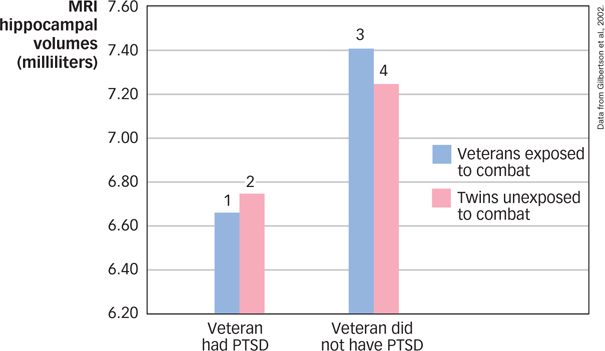14.4 Posttraumatic Stress Disorder: Troubles after a Trauma

Psychological reactions to stress can lead to a class of mental disorders that the DSM-
posttraumatic stress disorder (PTSD)
A disorder characterized by chronic physiological arousal, recurrent unwanted thoughts or images of the trauma, and avoidance of things that call the traumatic event to mind.
454
Psychological scars left by traumatic events are nowhere more apparent than in war. Many soldiers returning from combat will experience symptoms including flashbacks of battle, exaggerated anxiety and startle reactions, and even medical conditions that do not arise from physical damage (e.g., paralysis or chronic fatigue). Most of these symptoms are normal, appropriate responses to horrifying events, and for most people, the symptoms subside with time. In PTSD, the symptoms can last much longer. For example, approximately 12% of U.S. veterans of recent operations in Iraq met criteria for PTSD after their deployment (Keane, Marshall, & Taft, 2006). The effects of PTSD are now recognized not only among the victims, witnesses, and perpetrators of war, but also among ordinary people who are traumatized by terrible events in civilian life. About 7% of Americans are estimated to suffer from PTSD at some time in their lives (Kessler, Berglund, et al., 2005).
Not everyone who is exposed to a traumatic event develops PTSD, suggesting that people differ in their degree of sensitivity to trauma. Research using brain imaging techniques has identified important neural correlates of PTSD. Specifically, those with PTSD show heightened activity in the amygdala (a region associated with the evaluation of threatening information and fear conditioning), decreased activity in the medial prefrontal cortex (a region important in the extinction of fear conditioning), and a smaller sized hippocampus (the part of the brain most linked with memory, as described in the Memory chapter; Shin, Rauch, & Pitman, 2006). Of course, an important question is whether people whose brains have these characteristics are at greater risk for PTSD if traumatized, or if these are the consequences of trauma in some people. For instance, does reduced hippocampal volume reflect a preexisting condition that makes the brain sensitive to stress, or does the traumatic stress itself somehow kill hippocampal cells? One important study suggests that although a group of combat veterans with PTSD showed reduced hippocampal volume, so did the identical (monozygotic) twins of those men (see FIGURE 14.1), even though the twins had never had any combat exposure or developed PTSD (Gilbertson et al., 2002). This suggests that the veterans’ reduced hippocampal volumes weren’t caused by the combat exposure; instead, both these veterans and their twin brothers might have had a smaller hippocampus to begin with, a preexisting condition that made them susceptible to developing PTSD when they were later exposed to trauma.

What structure in the brain might be an indicator for susceptibility to PTSD?
455
SUMMARY QUIZ [14.4]
Question 14.9
| 1. | Which of the below is not a symptom of PTSD? |
- chronic physiological arousal
- avoidance of things or places that might serve as reminders of the traumatic event
- recurrent, intrusive thoughts about the traumatic event
- impaired acquisition of conditioned fear responses
d.